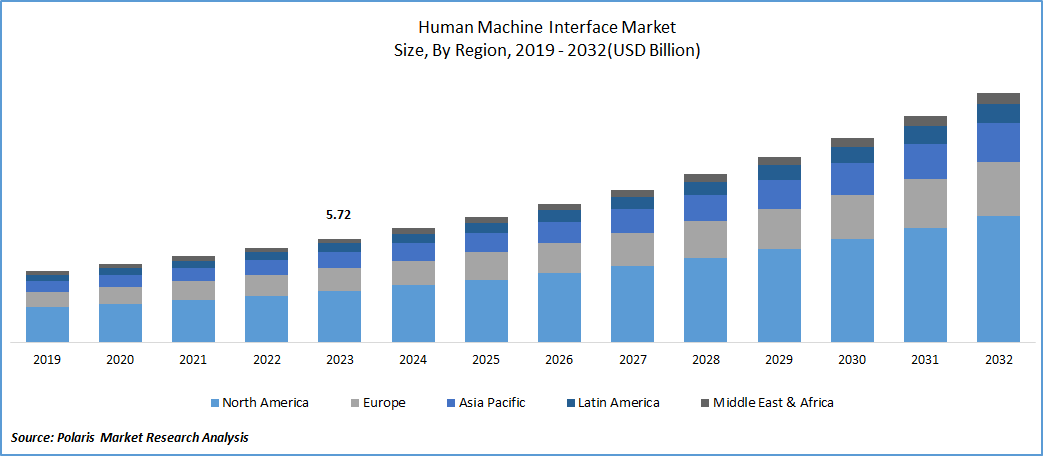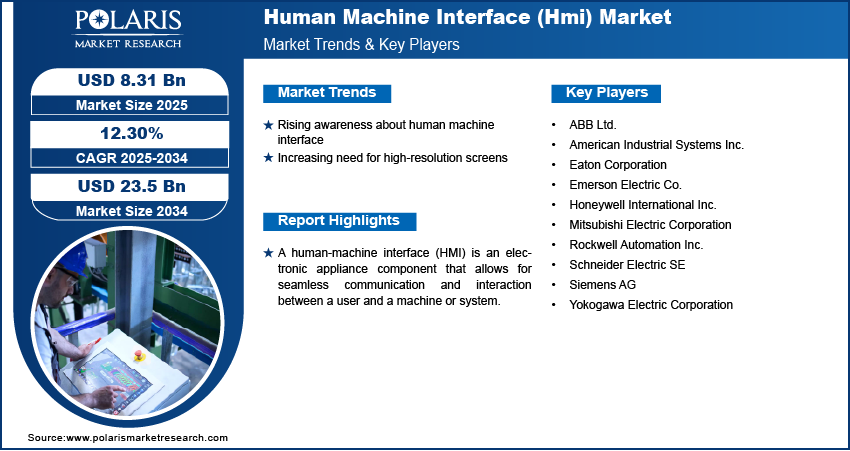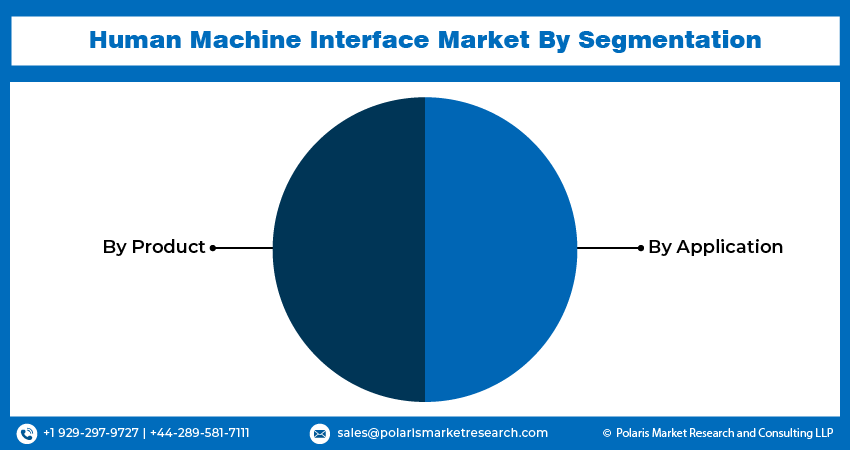
Human Machine Interface (HMI) Market Share, Size, Trends & Industry Analysis Report
By Product (Display Terminals, Interface Software, Industrial PCs, Others); By Application; By Region; Segment Forecast, 2025 - 2034
- Published Date:Oct-2025
- Pages: 155
- Format: PDF
- Report ID: PM1462
- Base Year: 2024
- Historical Data: 2020-2023
Market Overview
The global human machine interface (HMI) market was valued at USD 7.4 billion in 2024 and is projected to grow at a CAGR of 12.30% from 2025 to 2034. The market is fueled by the growing demand for automation and user-friendly control systems in industrial operations.
Key Insights
- In 2024, the interface software segment commanded the largest share of revenues, driven by its role in facilitating seamless and effective user interactions, as well as efficient communication between devices.
- The automotive segment commanded the biggest market share during the forecast period, spurred by advanced, embedded HMI technologies that enhance dashboard design and improve road safety.
- In 2024, North America dominated the human-machine interface market due to its wide range of industries requiring sophisticated HMI solutions.
- Asia Pacific is projected to expand at the highest pace, driven by high-end R&D and innovative technologies such as flexible, skin-mounted HMIs.
Industry Dynamics
- Increasing demand and access to high-resolution screens across all economies will enhance industrial efficiency and propel market growth.
- The increasing demand for high-resolution screens to enhance process analysis will drive significant growth.
- Increasing awareness and advancements in human-machine interface (HMI) technology in various applications are expected to drive the market's growth.
- The complexity of technology and high implementation costs can hinder the full-scale adoption of human-machine interface (HMI) technologies.
Market Statistics
2024 Market Size: USD 7.4 billion in 2024
2034 Projected Market Size: USD 23.5 billion
CAGR (2025-2034): 12.3%
North America: Largest Market Share

Know more about this report: Request a Free Sample Report
A human-machine interface (HMI) is an electronic appliance component that allows for seamless communication and interaction between a user and a machine or system. The HMI, which consists of various software and hardware components, converts human inputs into signals that the machine use to generate results.
It also makes use of motion sensors, peripheral devices, speech-recognition interfaces, and other tools to convey information through sound, sight, heat, and touch. This technology not only reduces errors but also improves customer satisfaction, efficiency, and overall comfort.
Increasing demand for and accessibility of high-resolution displays in both developing and developed economies to improve the efficiency of industrial processes is poised to significantly expand the growth potential. Furthermore, ongoing technological advancements in computer processors are expected to present even more significant opportunities.
- For instance, In February 2023, Exor, a leader in human-machine interface solutions, introduced the eX707M (Web Industrial HMI), specifically crafted for industrial automation purposes. This HMI system features an integrated web server, making it ideal for integration into factory automation systems.
The industry has witnessed numerous advances in technology, ranging from Light Emitting Diode (LED) indicators to fully operational touchscreen terminals with graphic capabilities. The incorporation of Bluetooth and Wi-Fi into these devices has increased their mobility, resulting in an expected surge in demand throughout the forecast period.
The COVID-19 pandemic has had a significant impact on the human machine interface (HMI) market, causing a surge in the adoption of automation and digitization across a wide range of industries. With lockdowns and social distancing measures in place, there was a surge in demand for touchless or remote-operated interfaces to reduce physical contact. As a result, there has been an increase in the development and deployment of advanced HMI technologies such as gesture control, augmented reality and voice recognition, interfaces. Furthermore, industries such as healthcare, manufacturing, and logistics have accelerated their digital transformation efforts, increasing demand for HMI solutions to improve operational efficiency and ensure business continuity during the pandemic. However, the global health crisis supply chain disruptions and economic uncertainties posed challenges for the HMI market. Despite these challenges, COVID-19's overall impact has accelerated the adoption of innovative HMI solutions, fostering long-term growth and resilience in the industry.
The increasing need for high-resolution screens for efficient process analysis is anticipated for substantial growth. Additionally, the continued enhancements and upgrades in computer processors are anticipated to replace conventional systems, thereby driving up product demand. The progress in broadband access technology is also poised for significant growth in the forecast period.

Industry Dynamics
- Rising awareness about human machine interface will drive the growth of the market
The increasing awareness about human machine interface will drive the growth of the market. Human Machine Interface (HMI), which facilitates secure messaging and improves internal communication and alarm systems, is expected to drive overall growth. The market is expected to benefit from technological advancements and increased internet adoption. HMI is increasingly being used in a variety of applications, including ATMs, self-service kiosks, gas station pumps, industrial robots, self-checkout lines, and others. These interfaces allow for the processing of user inputs, conversion into machine-readable code, and independent execution of tasks without the assistance of employees or attendants.
Self-ordering kiosk systems are becoming more popular in the retail and restaurant industries. Self-service kiosks are being integrated into many businesses, including GRUBBRR, KFC, Maccas, Jubilant FoodWorks Ltd., and others, to streamline operations, improve customer experiences, and provide convenient alternatives. These businesses hope to eliminate queues, increase employee productivity, and provide customers with faster and more accurate order processing by implementing self-ordering kiosks.
Report Segmentation
The market is primarily segmented based on product, application, and region.
|
By Product |
By Application |
By Region |
|
|
|
To Understand the Scope of this Report: Speak to Analyst
By Product Analysis
- The interface software segment accounted for the largest revenue share in 2024
In 2024, the interface software segment held the largest revenue share. Interface software is crucial in facilitating information exchange among computer system components. Advances in the application development process can result in smaller application sizes and faster computing speeds. Touchscreens, voice recognition, and gesture control are also built into interface software, allowing for a wide range of intuitive interactions. The design of interface software has a significant impact on user accessibility and efficiency, with the goal of creating user-friendly environments across a wide range of devices and applications.
By Application Analysis
- The automotive segment accounted for the highest market share during the forecast period
The automotive segment held the highest market share during the forecast period. The automotive industry has transformed significantly, using advanced technology to create a more flexible, dynamic, and adaptable design for car dashboards. While independent systems create safety risks, integrating speech input/output systems with Human-Machine Interfaces (HMIs) has the potential to reduce distractions for drivers while driving and foster industry growth.
On the other hand, oil & gas segment is expected for fastest growth during the forecast period. Human-machine interfaces in the oil and gas industry are being enhanced to provide improved data visualization and analytical capabilities. These interfaces enable operators to interpret complex data sets, track performance metrics, and detect real-time patterns or irregularities. This improves the ability to make data-driven, informed decisions, streamline processes, and improve overall operational performance.

Regional Insights
- North America accounted for the largest market share in 2024
North America human machine interface market accounted for the largest share in 2024. North America has a diverse industrial base that comprises sectors such as manufacturing, automotive, aerospace, energy, and healthcare. These industries have a high demand for sophisticated human machine interfaces (HMIs) to improve process efficiency, productivity, and user experience. The region's substantial industrial footprint provides a large customer base and market potential for HMI vendors.
Asia Pacific human machine interface market is expected to grow fastest during the forecast period. The advancement of R&D focused on pioneering human machine interface (HMI) solutions in this region is anticipated to boost overall growth, for instance, on January 8, 2022, of a Closed-Loop Human-Machine Interface (CL-HMI) by Chinese scientists. This innovation involves directly attaching flexible electronics to the user's skin, allowing haptic feedback control of robots via Bluetooth, Wi-Fi, and the internet. Traditional HMIs are distinguished by their large size, high cost, and limited applicability.

Key Market Players & Competitive Insights
The human machine interface market is characterized by intense competition, with established players relying on advanced technology, high-quality products, and a strong brand image to drive revenue growth. These companies employ various strategies such as research and development, mergers and acquisitions, and technological innovations to expand their product portfolios and maintain a competitive edge.
Some of the major players operating include:
- ABB Ltd.
- American Industrial Systems Inc.
- Eaton Corporation
- Emerson Electric Co.
- Honeywell International Inc.
- Mitsubishi Electric Corporation
- Rockwell Automation Inc.
- Schneider Electric SE
- Siemens AG
- Yokogawa Electric Corporation
Recent Developments
- In July 2024, Mouser Electronics launched a new installment of its Empowering Innovation Together series, focusing on human-machine interfaces (HMI). The series explored HMI advancements and their societal impact, featuring industry experts and discussing the future of intuitive, user-centric designs.
- In January 2023, Sibros and Marelli have partnered to bring cutting-edge over-the-air solutions to the next-generation vehicle's cockpit. The MInD-Xp platform from Marelli will include a domain control unit (DCU) that will manage a variety of in-cabin functions, elevating both driver and passenger experiences with a seamless Human-Machine Interface (HMI).
- In June 2022, The Qt Company, an innovator in software technology, has partnered with Bosch. Bosch is set to implement Qt's comprehensive cross-platform Human Machine Interfaces (HMI) design and development framework, empowering automotive manufacturers with the necessary tools to craft a ready-to-deploy automotive digital cockpit solution.
- In September 2021, Renesas Electronics Corporation, a leading provider of advanced semiconductor solutions, has launched the 32-bit RX671. This advanced offering combines superior performance and energy efficiency with user-friendly Human Machine Interface (HMI) capabilities, allowing for contactless operation.
Human Machine Interface Market Report Scope
|
Report Attributes |
Details |
|
Market size value in 2025 |
USD 8.31 billion |
|
Revenue forecast in 2034 |
USD 23.5 billion |
|
CAGR |
12.3% from 2025 – 2034 |
|
Base year |
2024 |
|
Historical data |
2020 – 2023 |
|
Forecast period |
2025 – 2034 |
|
Quantitative units |
Revenue in USD billion and CAGR from 2025 to 2034 |
|
Segments Covered |
By Product, By Application, By Region |
|
Regional scope |
North America, Europe, Asia Pacific, Latin America; Middle East & Africa |
|
Customization |
Report customization as per your requirements with respect to countries, region and segmentation |
FAQ's
Human Machine Interface Market report covering key segments are product, application, and region.
Human Machine Interface Market Size Worth $ 23.5 Billion By 2034.
The global human machine interface market is expected to grow at a CAGR of 12.30% during the forecast period.
North America is leading the global market.
The key driving factors in Human Machine Interface Market is Rising awareness about human machine interface will drive the growth of the market
